There are several ways to go about planning. A napkin scribble might work for a weekend DIY project. A simple to-do list is sufficient for organizing a small team event. However, when projects grow in complexity and vulnerability, these casual approaches fall short.
That’s where the Critical Path Method (CPM) comes into picture. In short, it’s the careful evaluation of the longest stretch of tasks and activities that defines when our project will meet its closure. Or, as my colleague likes to call it, “a tightrope that a client makes the project team walk on.”
Project planning demands precision, foresight, and a strategic approach that goes beyond listing to-dos and hoping for the best. The critical path method helps you take the guesswork out of your planning and provides a scientific approach to creating a transparent network of tasks and activities.
In this article, I will break down this ingenious method for you. I will discuss how it works. How can you allocate resources where they matter most, predict potential delays, and make informed decisions? With CPM, you can create a clear action plan, ensuring that every decision you make drives your project toward successful, on-time completion.
What is the Critical Path Method?
Critical Path Method (CPM) is a project management technique designed to schedule and manage complex projects with interdependent tasks. It calculates the minimum time required to complete a project by analyzing the sequence of activities directly impacting the project duration, known as the critical path.
Developed in the late 1950s by James E. Kelley of Remington Rand and Morgan R. Walker of DuPont, CPM uses a network that depicts activities in a flow to represent an execution sequence. The technique is so effective that it has been used in major projects like the construction of the World Trade Center Twin Towers and contributed to the success of the Manhattan Project.
Early project managers relied on hand-drawn network diagrams and manual calculations to map critical paths, a detailed process vulnerable to errors and delays. Today, modern project management software like ProofHub has reshaped CPM, automating intricate computations and delivering real-time insights. These tools streamline task sequencing, enhance accuracy, and enable seamless team collaboration. This shift from paper to screens has made CPM more practical and powerful than ever.
Why is it called “Critical”?
For example, if you’re building a house, you can’t put up the walls until the foundation is poured—that’s a critical task with no shortcuts. Flexible tasks, on the other hand, have some slack. Maybe you can order furniture a little late or paint the rooms in a different order without holding up the move-in date.
The term “Critical” comes from the fact that this method highlights the tasks you can’t let slip. If delayed, these are the ones that push the whole project’s end date forward. In a project, not every task carries the same weight. Some tasks are critical: they’re locked into a specific order or timeline, and there’s no wiggle room without throwing everything off. Others are more flexible: they can be shifted, delayed a bit, or even tackled alongside other tasks without risking the whole plan. The critical path is the sequence of those vital tasks—the ones that have to happen on time and in order, because they directly determine when the project wraps up.
Because the critical path shows you exactly where a delay will hurt the most, if a task on this path slips, the whole project’s completion date slides back. That’s what makes the critical path “critical”—it’s the line you can’t cross without consequences.
Key aspects of the critical path
At its core, CPM deconstructs projects into four fundamental elements:
- Tasks
- Dependencies
- Time estimation
- Resource estimation
Simply put, how well you can define each element decides how perfect your critical path will be.
The method can further be broken down into two stages:
1. Critical path analysis: Creating and analyzing the longest queue in your project roadmap that affects the on-time delivery of the project.
2. Critical path management: Planning and optimization associated with resolving the risks found in critical path analysis.
Before we discuss how each of these aspects works out in reality, let’s first understand the benefits of using CPM.
Why use the Critical Path Method?
CPM originated from the need to reduce the increased cost caused by inefficient scheduling. Its deterministic nature takes out the pseudo-sense of control or guesswork involved in predicting the actual date of delivery. This, in turn, helps the project manager, or anyone responsible for scheduling, with better allocation of resources and provides accurate and effective control over the project timeline.
The benefits can be manifold, but they can be boiled down to the following three:
Better planning: Planning ahead of time has been a key to competitive advantage in the business world. But there is only so much you can plan with any significant certainty. Not to mention, planning has become even more unconventional in the modern dynamic world. However, having a structured roadmap that lets you see in the near future helps you plan better for the future to follow. You can better manage the uncertainties along the line and indirectly shorten the projected distance to your desired outcomes.
Better workload distribution: CPM allows you to allocate work to your team better. Usually, we overestimate the ability of our team to meet the deadlines. But, if tasks are displayed as a bar chart, like a Gantt chart, it is easy to see where the team member can suffer. Over time, you’d better analyze where your team might reach their limits and where they can burn out, helping you optimize your plan accordingly.
Continuous improvement: Things do not always go as planned. As the project proceeds, the baseline schedule developed from the initial critical path analysis can be used to track schedule progress. Throughout a project, a manager can identify tasks that have already been completed, the predicted remaining durations for in-progress tasks, and any planned changes to future task sequences and durations. The result will be an updated schedule, which, when displayed against the original baseline, will provide a visual means of comparing planned with actual progress.
What is Critical Path Analysis (CPA)?
Critical Path Analysis involves analyzing the sequence of tasks that form the critical path to determine their impact on the project’s timeline. The goal is to identify potential risks, optimize resource allocation, and ensure timely project delivery.
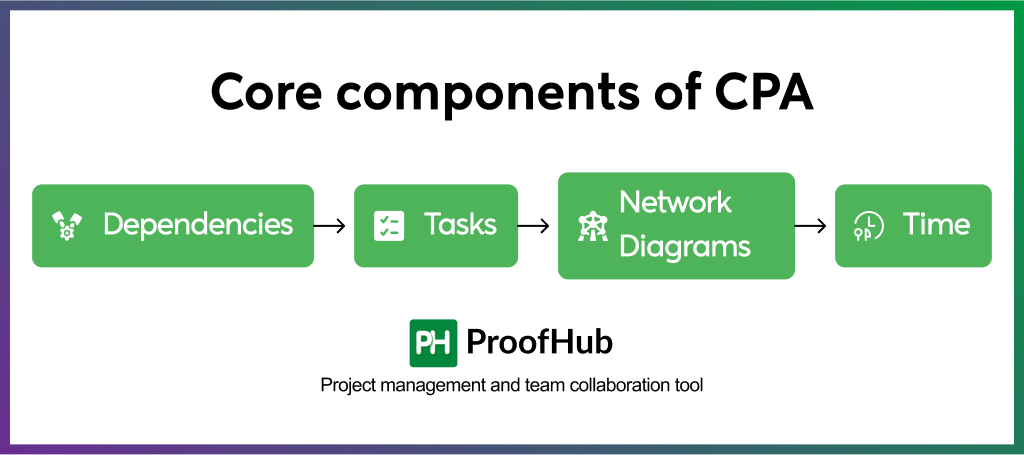
Core components of CPA
1. Tasks
Tasks are the individual units of work that need to be completed. Each task should have:
- Start and end dates
- Clear description (e.g., “Design homepage wireframe”)
- Assigned team member(s) (e.g., “UI Designer – Sarah”)
- Estimated duration (e.g., “3 business days”)
2. Dependencies
Dependencies show how tasks relate to each other, ensuring your project flows smoothly. Consider these key logical relationships:
- Finish to start (FS): A task can only start once the preceding task has finished.
Example: Content writing must finish before content review can begin.
- Start to start (SS): A task can start only when the preceding task starts.
Example: Quality assurance can begin once development starts, running in parallel.
- Finish to finish (FF): A task can be finished only when the preceding task is finished.
Example: Final documentation cannot be completed until all product testing is finished.
- Start to finish (SF): A task can finish only when the preceding task starts. This is rare but can be seen in specific scenarios.
Example: The night security shift (Task A) cannot end until the day security shift (Task B) begins.
Additionally, other factors affecting task scheduling include:
- Resource dependencies: While traditional CPA focuses on logical dependencies, resource constraints (when tasks share equipment or personnel) are typically addressed in resource levelling, a separate but complementary process to critical path analysis.
- Sequences: Scheduling uncertainties (such as overlapping tasks or coordination issues) can cause delays in project execution.
By mapping these connections, you ensure that a delay in one area doesn’t derail the entire project.
3. Time
Critical Path Method (CPM) helps you measure project progress by:
- Estimating task duration: Determining how long each task will take.
- Identifying time-critical tasks: Pinpointing which tasks impact the overall timeline the most.
- Understanding impact: Seeing how delays in one area affect the entire project.
Techniques such as forward and backwards pass calculations (discussed below) allow you to determine:
- Earliest start time (EST): When a task can begin based on previous tasks.
- Latest finish time (LFT): The last moment a task can be finished without affecting the deadline.
4. Network Diagrams
A network diagram is a roadmap that shows every route and potential detour. It shows:
- All tasks and their sequences: Laying out the order in which tasks should occur.
- Potential bottlenecks: Highlighting where tasks with no slack might slow progress.
- Critical paths: Identifying sequences that cannot afford delays.
Tip: Treat your first network diagram as a prototype. Collaborate with your team to refine it until it accurately reflects real-world constraints.
How to create a Critical Path?

Follow these steps to implement the Critical Path Methodology effectively:
1. Identify all project activities
- Start by cataloguing every task that the project encompasses.
- Create a comprehensive inventory using a Work Breakdown Structure (WBS)
- Divide the project into smaller, manageable segments
- Detail each task with clear descriptions, assigned resources, and estimated durations
Example: For a website redesign, activities might include “Stakeholder interviews,” “Wireframing,” “Design approval,” etc.
2. Determine task dependencies
- Following the identification of activities, outline the sequence in which these tasks should occur.
- Map out which tasks are prerequisites for others
- Establish logical relationships using the dependency types (FS, SS, FF, SF)
Example: “Content creation” must be completed before “Content upload”
3. Develop a network diagram
- Create a network diagram to visually map out the sequence and dependencies of tasks
- Use nodes to represent tasks and arrows to show dependencies
- Consider using specialized software like Microsoft Project or Primavera
- Highlight potential bottlenecks and critical paths
Example: A flowchart showing how “Design approval” leads to “Development” with time estimates
4. Estimate activity durations
- Predicting the duration of each task accurately is vital for effective CPM implementation
- Use historical data from similar projects
- Gather expert opinions from team members
- Consider using three-point estimation (optimistic, most likely, pessimistic)
Example: “Backend development” estimated at 10 business days based on similar past projects
5. Identify the critical path
- With the network diagram and duration estimates in place, focus on identifying the critical path.
- Perform the necessary calculations (forward pass, backward pass, float)
- Flag zero-float activities that directly impact project completion
Example: The sequence “Design → Development → Testing → Deployment” forms the critical path
Calculations involved in Critical Path Analysis
Forward pass calculation
The forward pass calculation begins at the project’s initiation, establishing the earliest start (ES) and finish (EF) for each task.
- Start at day 0 for the first task
ES for dependent tasks equals the EF of their predecessors
EF = ES + Task Duration
Example calculation:
Task A (3 days): ES = 0, EF = 3
Task B (depends on A, 4 days): ES = 3, EF = 7
Backward Pass Calculation
The backward pass calculation outlines the latest times tasks can start and finish without shifting the project’s deadline.
- Set the LF of the final task to equal its EF (or the project deadline)
- Work backwards through the network
LS = LF – Task Duration
Example calculation (continuing from above):
Task C (final task, 2 days): LF = 9 (project deadline), LS = 7
Task B (precedes C, 4 days): LF = 7, LS = 3
Float calculation
Float, or slack, quantifies how much delay a task can absorb before affecting the project duration.
Float = LS – ES (or LF – EF)
Zero-float tasks form the critical path
Example calculation:
Task A: LS (3) – ES (0) = Float of 3 days (not on critical path)
Task B: LS (3) – ES (3) = Float of 0 days (on critical path)
Task C: LS (7) – ES (7) = Float of 0 days (on critical path)
Tasks B and C form the critical path in this example, as any delay in either will extend the overall project duration.
Why analyze the Critical Path?
Analyzing the Critical Path offers a strategic perspective that enhances project management by shedding light on pivotal tasks that dictate project timelines. This analysis enables managers to identify and focus on tasks with the most significant influence on project duration, thereby facilitating proactive management of potential scheduling issues.
A thorough examination of the Critical Path enables project managers to fine-tune their resource distribution strategies. By understanding which tasks are indispensable for timely project completion, resources can be allocated precisely, ensuring that critical activities receive priority attention. This foresight allows for developing robust contingency plans, ensuring that projects remain resilient in the face of unexpected disruptions.
Pitfalls in Critical Path Analysis
Critical Path Analysis is certainly valuable, but it does come with its own set of challenges. One notable pitfall is the affinity for overly optimistic scheduling. Project managers might underestimate the time required for each task or overestimate resource availability, resulting in too tight schedules. This optimism can lead to timelines that don’t account for potential setbacks, putting the entire project at risk if unforeseen issues arise.
Another challenge is the potential oversight of task interdependencies. Inadequate mapping of these relationships can disrupt the logical flow of activities, leading to unexpected delays. This issue often stems from a lack of comprehensive analysis or insufficient documentation of how tasks interconnect. Ensuring thorough examination and detailed recording of all dependencies is essential to avoid such disruptions.
Lastly, adapting to static timelines is a significant concern. Projects are dynamic by nature, with scope changes, resource reallocation, and external factors influencing the original schedule. Sticking rigidly to an initial timeline without incorporating these changes can cause misalignment between the project plan and its execution. Projects require adaptable schedules that can accommodate evolving circumstances, ensuring they stay aligned with objectives despite shifting conditions.
Techniques for managing the critical path
Effective critical path management is crucial for ensuring a project’s successful execution. This involves recognizing the critical path and dynamically managing it to enhance project performance.
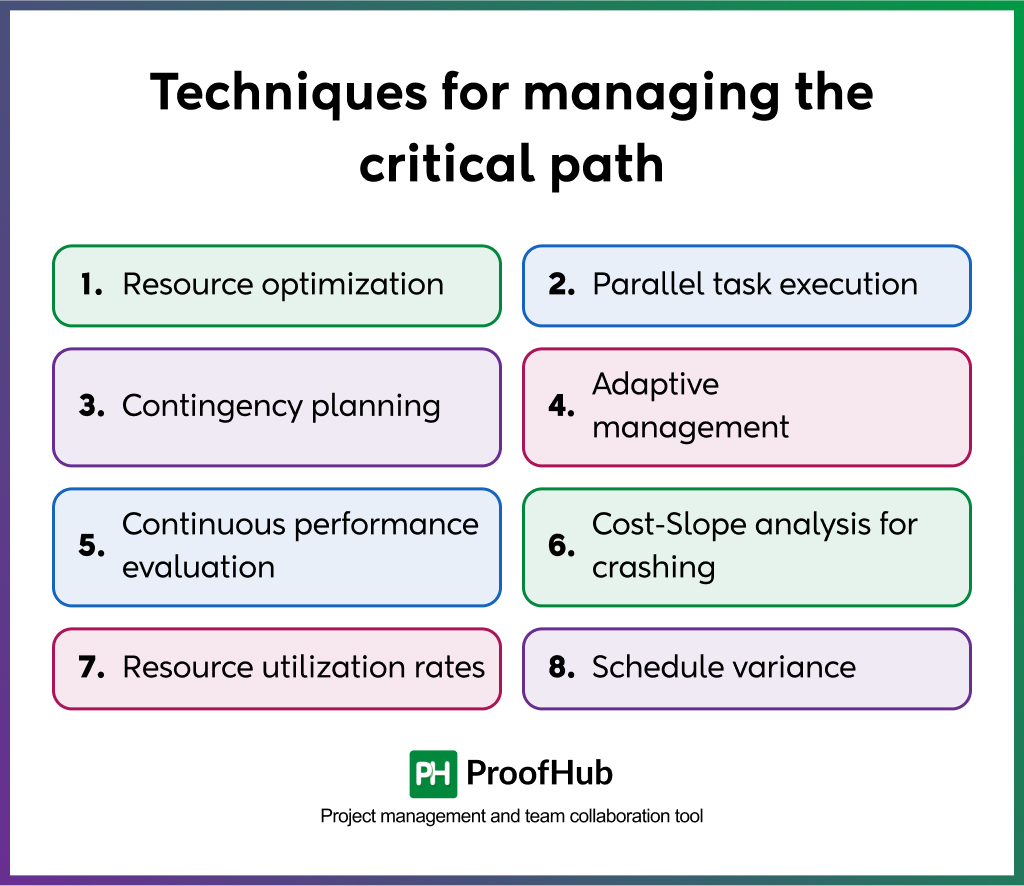
By focusing on the critical path and adapting strategies as needed, project managers can ensure alignment with objectives and efficient use of resources.
- Resource optimization: Prioritize allocation of limited resources to critical path tasks, preventing potential delays and maximizing productivity where it matters most to project timelines.
- Parallel task execution: Identify opportunities to execute non-dependent tasks concurrently, and evaluate whether additional resources on specific tasks can accelerate progress without compromising quality. These approaches require careful planning to mitigate risks.
- Contingency planning: Strategically introduce time buffers at key junctures within the project timeline to absorb disruptions from unexpected changes or delays, preserving overall schedule integrity. Incorporate calculated time margins that can absorb minor setbacks without affecting overall deadlines, allowing teams to maintain momentum despite small disruptions.
- Adaptive management: Maintain regular oversight using project management tools to gain insights into task progress and resource deployment. This approach requires openness to revising plans, incorporating new data, and modifying strategies for effective deadline management. Redistribute workloads to prevent both underutilization and overextension of team members, maintaining optimal efficiency throughout the project lifecycle. This requires understanding both task priorities and individual capabilities.
- Continuous performance evaluation: Performance evaluation is integral to aligning with project objectives. Employing tools like performance dashboards and project analytics gives project managers a comprehensive view of progress. These tools offer real-time insights into task completion rates and resource utilization, allowing managers to identify deviations early and implement timely corrections. By leveraging these insights, project managers can ensure that the project proceeds smoothly and stays on course.
- Cost-Slope analysis for crashing: Cost-slope analysis is a valuable tool in CPM, particularly when assessing the financial impact of accelerating project timelines through crashing. Evaluate the financial impact of accelerating specific tasks by calculating the ratio of additional cost to time saved. This helps identify which critical path activities can be expedited most economically when deadlines tighten, allowing for informed decisions about where to invest additional resources.
- Resource utilization rates: Analyzing resource utilization rates provides critical insights into the efficiency of resource application throughout the project lifecycle. By calculating these rates, managers can detect imbalances in resource allocation, whether it be underutilization or excessive workload. Monitor the percentage of time resources are actively engaged in project work relative to their availability via time tracking. This helps prevent both underutilization and overallocation, ensuring team members maintain optimal productivity without burnout, particularly on critical path activities.
- Schedule variance: Schedule variance (SV) is a crucial measure for evaluating whether project progress aligns with the planned timeline. Calculated by subtracting the planned value (PV) from the earned value (EV), SV provides a snapshot of schedule performance.
- SV = EV – PV
A positive value indicates that the project is advancing ahead of schedule, whereas a negative value suggests delays, prompting corrective measures.
By routinely assessing these aspects, project teams can swiftly address divergences, ensuring that the project remains aligned with its strategic objectives and milestones.
Benefits of the Critical Path Method
By implementing CPM, organizations gain powerful insights that drive efficiency and support strategic decision-making at every level, from executive stakeholders to individual team members.
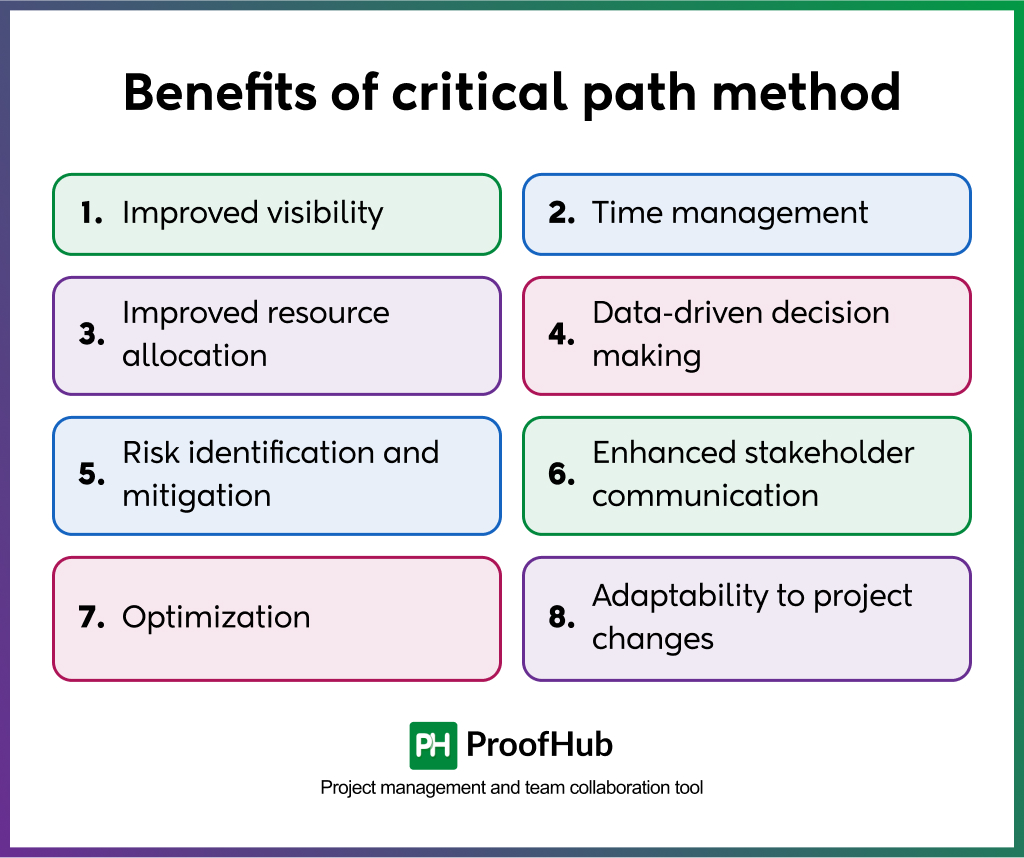
Here are some of the key benefits of CPM:
- Improved visibility: CPM provides a clear visualization of task sequences and dependencies through network diagrams, enabling all stakeholders to understand the project structure at a glance. This visibility eliminates confusion about task priorities and creates alignment across the team.
- Time management: By identifying the critical path of tasks that directly impact project completion dates, CPM allows managers to focus attention on activities where delays would threaten overall deadlines. This prioritization ensures efficient use of time and resources on tasks that truly matter.
- Improved resource allocation: CPM highlights when and where resources are most needed, helping project managers distribute personnel, equipment, and budget strategically throughout the project timeline. This prevents resource bottlenecks and minimizes costly idle time.
- Data-driven decision making: When changes or disruptions occur, CPM provides objective data to evaluate impacts and make informed decisions about adjustments. This analytical approach replaces guesswork with concrete evidence, leading to more effective problem-solving.
- Risk identification and mitigation: By exposing task dependencies and time constraints, CPM helps teams identify potential failure points early in the planning process. This foresight enables proactive risk management strategies before problems materialize.
- Enhanced stakeholder communication: CPM creates a shared visual language for discussing project progress and challenges with clients, executives, and team members. This clarity builds confidence in project commitments and facilitates productive conversations about timeline adjustments.
- Optimization: The critical path’s connection to project duration directly impacts costs, allowing finance teams to forecast budgets more accurately and identify opportunities for cost efficiency without compromising delivery timelines.
- Adaptability to project changes: When scope adjustments or unexpected events occur, CPM provides a structured method for evaluating impacts and recalibrating plans. This adaptability ensures the project remains viable and aligned with objectives despite changing conditions.
CPM in Agile environments
Combining CPM with Agile methods creates an opportunity to improve project delivery by flexibly joining structure. While Agile emphasizes adaptability and iterative progress, CPM adds strategic foresight for navigating complex projects. By thoughtfully blending these approaches, you can achieve harmony that leverages the strengths of both.
- Sprint planning enhancement: Use CPM during sprint planning to understand task sequences and dependencies. This ensures each sprint aligns with the broader project strategy, maintaining consistent progress toward key objectives. By identifying essential tasks for achieving milestones, teams can better manage workloads and anticipate disruptions.
- Adaptive iteration: Agile thrives on adaptability, which pairs well with CPM insights. After each sprint, reassess priorities and adjust plans based on current project conditions. This ongoing recalibration allows for responsive adjustment to changes, ensuring the team stays focused on delivering value as circumstances evolve.
- Resource optimization: Combine CPM’s structured resource management with Agile’s flexible team assignments. This creates better resource utilization across sprints while maintaining the ability to adapt to changing priorities.
- Risk-focused planning: Use CPM to identify high-risk dependencies within Agile iterations. This allows teams to develop contingency plans that maintain sprint momentum despite obstacles.
- Milestone tracking: Apply CPM techniques to monitor progress toward major milestones while preserving Agile’s short-term focus. This dual perspective helps teams balance immediate sprint goals with long-term project objectives.
Benefits of CPM in agile contexts
Employing CPM within Agile environments introduces several advantages:
1. Project visibility: CPM enhances clarity by providing a comprehensive view of task relationships and timelines. This helps coordinate teams and aligns individual efforts with overall project goals, creating shared understanding.
2. Risk identification: By highlighting critical dependencies and potential delays, CPM gives Agile teams the foresight to address risks before they become problems. This proactive approach allows for strategic resource allocation and reduces the impact of unforeseen challenges.
3. Informed decisions: CPM offers data-driven insights that help Agile teams prioritize tasks and allocate resources precisely. This informed decision-making ensures that Agile principles of delivering continuous value are maintained, even when project demands shift.
Challenges of Implementing CPM in Agile
While CPM can enhance Agile project management, several challenges must be addressed:
1. Balancing structure and flexibility: Agile’s dynamic nature may initially seem to conflict with CPM’s structured approach. You must find a balance allowing CPM’s strategic insights without undermining Agile’s inherent flexibility.
2. Ensuring consistent alignment: The ever-changing nature of Agile projects requires ongoing alignment between CPM insights and Agile practices. Regular evaluation and updates ensure both methodologies work together, supporting the project’s evolving needs.
3. Customization and flexibility: Different Agile teams may need tailored approaches to integrating CPM. Understanding team-specific workflows and adapting CPM practices accordingly ensures a seamless fit, allowing teams to benefit from structure while retaining adaptive capabilities.
Limitations of the Critical Path Method
The Critical Path Method (CPM) undoubtedly enhances project management. Yet, it operates on the assumption of static task durations, which can be problematic in dynamic project environments where variability is common. This can result in schedules that fail to account for unexpected changes, impacting the accuracy of projections and resource planning.
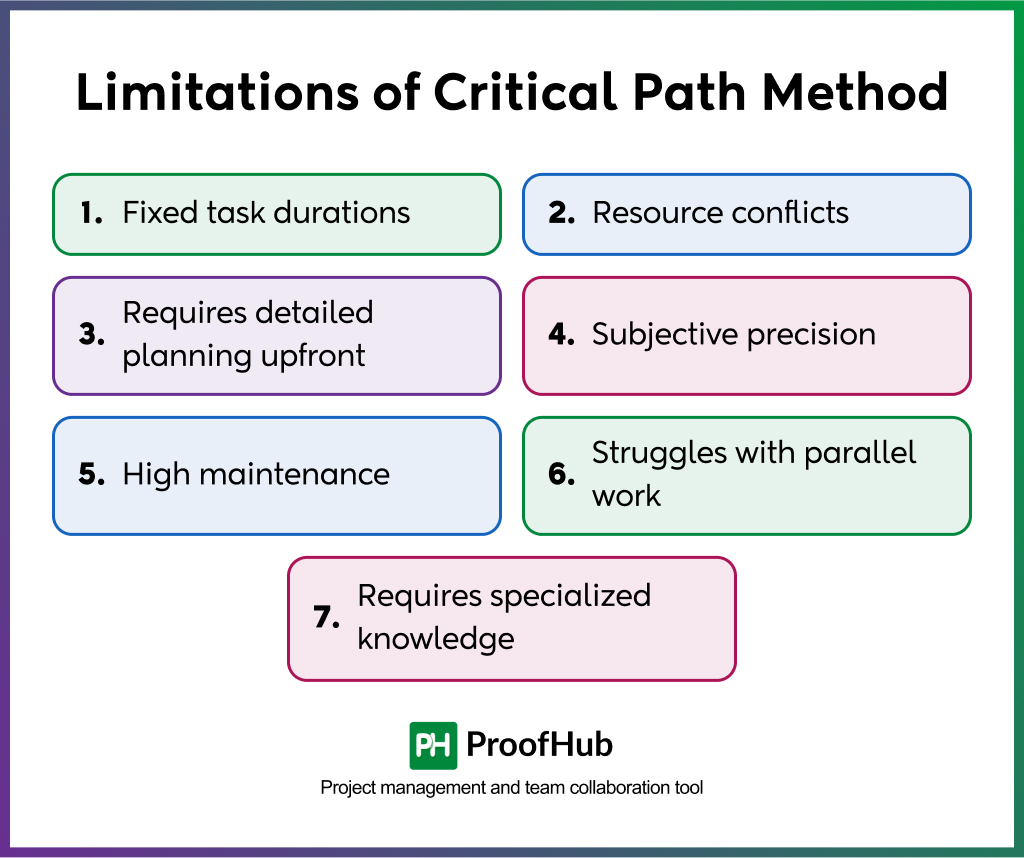
- Fixed task durations: CPM works with single time estimates for each task, which don’t account for the uncertainty common in real projects. This can lead to unrealistic schedules when tasks take longer than expected, causing ripple effects throughout the project.
- Resource conflicts: The traditional CPM approach focuses more on task timing than on who will do the work. This can create situations where multiple critical tasks need the same people or equipment simultaneously, causing unexpected delays.
- Requires detailed planning upfront: CPM needs thorough planning before work begins, which can be difficult when project requirements aren’t fully known. This makes it challenging to use in fast-changing environments where requirements evolve quickly.
- Subjective precision: The mathematical nature of CPM might suggest more certainty than actually exists. Teams sometimes place too much confidence in the calculated dates, ignoring the inherent uncertainty in project work.
- High maintenance: As projects progress and changes occur, keeping CPM diagrams and calculations updated can become time-consuming. Without regular updates, the critical path can become misleading rather than helpful.
- Struggles with parallel work: In modern work environments where many tasks happen simultaneously or iteratively, CPM’s linear approach can be restrictive. The method wasn’t designed for highly collaborative or rapidly changing work styles.
- Requires specialized knowledge: Properly implementing CPM requires training and experience. Without this expertise, teams might misinterpret results or apply the method incorrectly, leading to poor decisions.
Solution = ProofHub
Despite these challenges, the Critical Path Method remains a cornerstone of effective project management. The limitations of traditional CPM implementation can be significantly mitigated with modern project management solutions like ProofHub. Here’s how ProofHub addresses these common CPM challenges:
Dynamic task management: While traditional CPM relies on single time estimates, ProofHub allows for flexible duration management with features that make it easy to adjust timelines as new information emerges. The platform’s real-time updates ensure that when task durations change, the critical path is automatically recalculated, providing project managers with current, accurate information without manual recalculation.
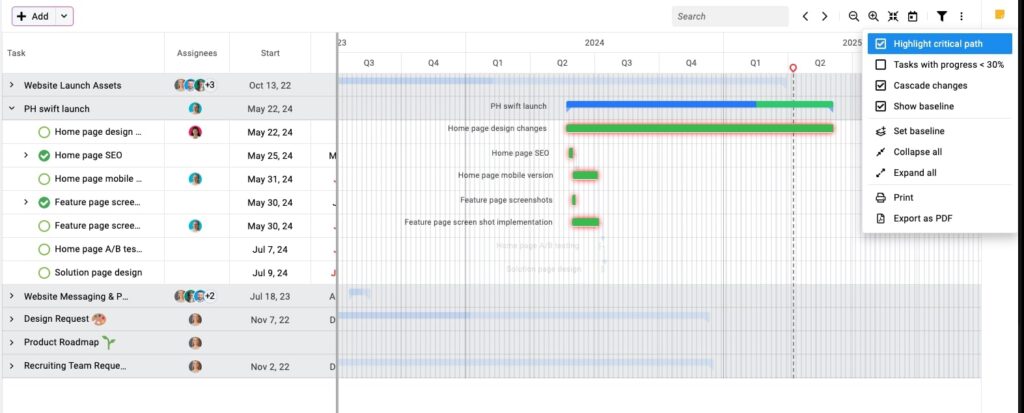
Strategic resource allocation: ProofHub integrates resource management directly with CPM analysis. The platform offers comprehensive views of team workloads, allowing managers to identify potential resource bottlenecks before they occur. This integrated approach ensures that critical path activities have the necessary resources when needed.
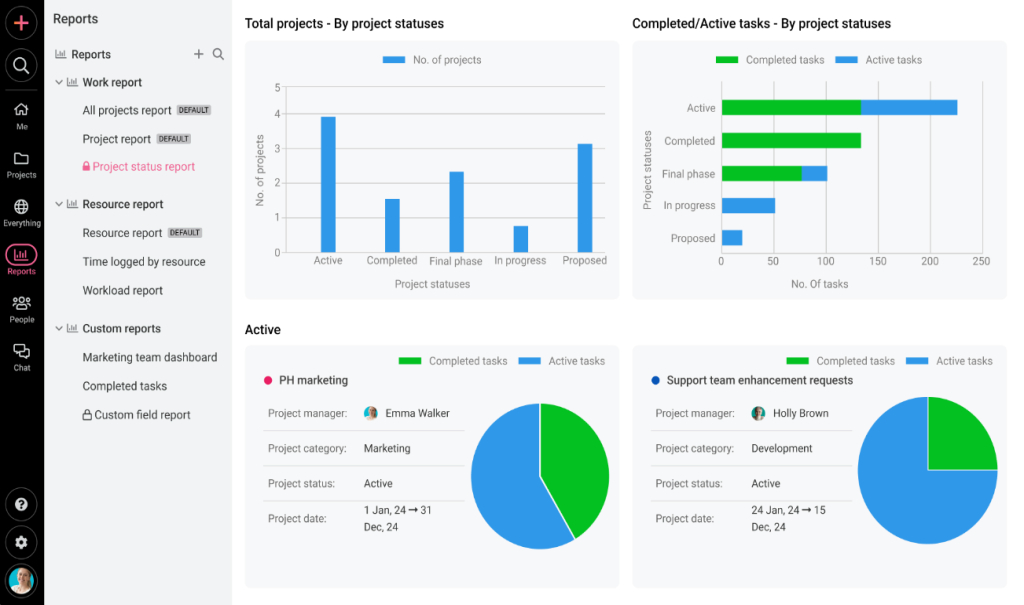
Adaptable planning: ProofHub’s dynamic tools allow for elaboration of progressive project or task details. Teams can begin with high-level planning and gradually add detail as requirements become clearer. The platform’s agile-friendly features support evolving project requirements while maintaining critical path integrity.
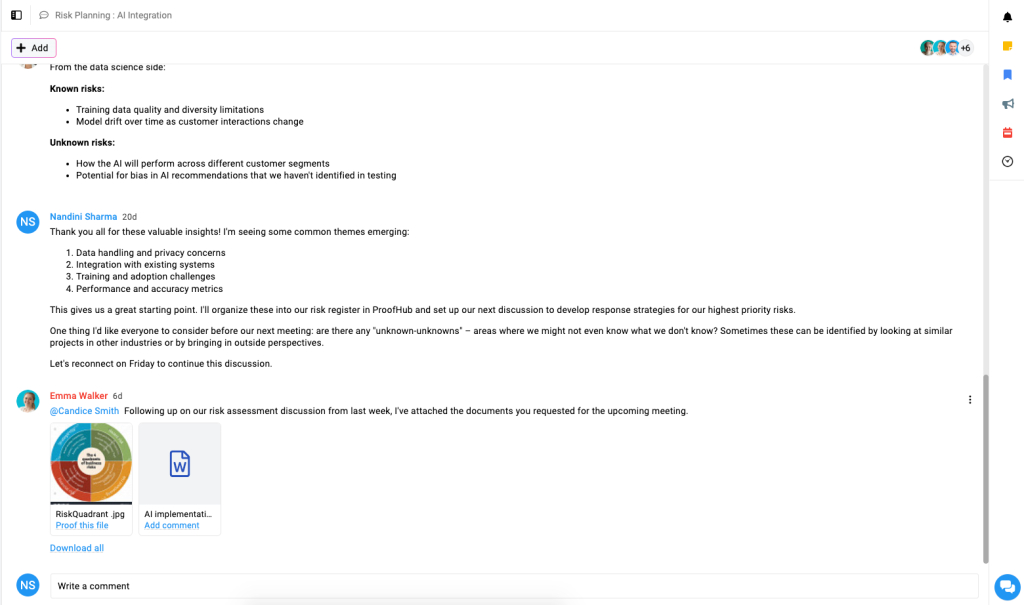
Real-time insights: ProofHub provides a clear visualization of project uncertainties alongside critical path information. The platform’s reporting capabilities help teams understand confidence levels in projected dates, preventing overreliance on seemingly precise calculations. This balanced approach keeps projects grounded in reality rather than mathematical idealism.
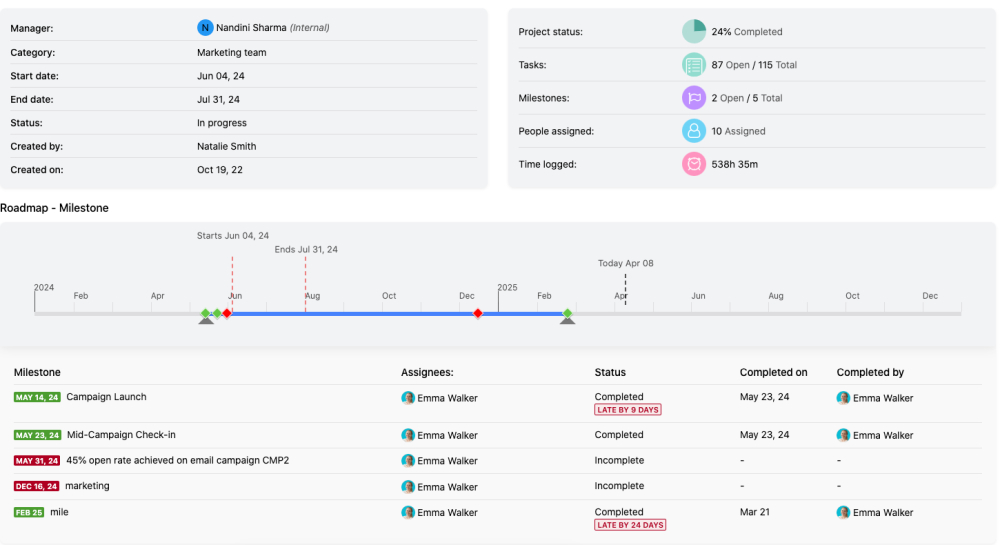
Effortless optimisation: With ProofHub’s task scheduling capabilities, critical path information remains current with minimal effort, as changes to durations, dependencies, or completions automatically update calculations. Moreover, you can cascade the changes throughout the entire timeline in a single click.
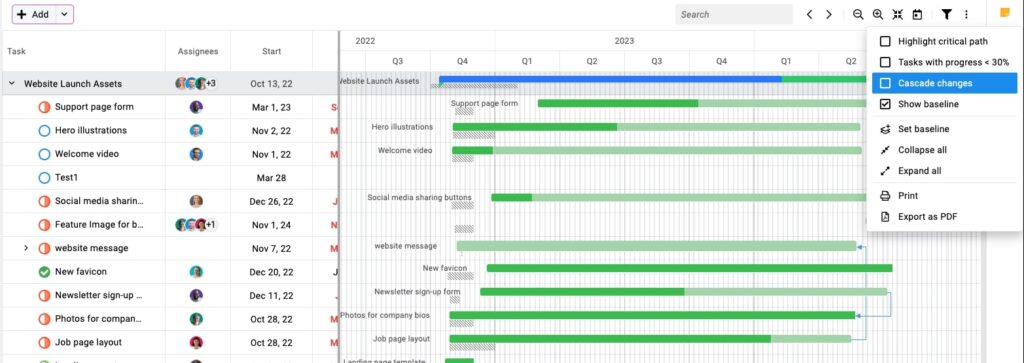
Support hybrid approaches: ProofHub enhances traditional CPM with features designed for contemporary collaborative work. The platform supports various project management methodologies, allowing teams to implement CPM principles within agile, hybrid, or traditional frameworks. This flexibility ensures that critical path management remains valuable even in highly collaborative environments.
User-friendly interface: ProofHub makes CPM easy through an intuitive interface that makes complex concepts accessible to all team members. The platform’s visual representations of the critical path require minimal specialized training to understand and act upon. This accessibility ensures that everyone can contribute to critical path management, not just certified project managers.
Conclusion
Project management is always evolving, and staying ahead means embracing both timeless principles and innovative solutions. As you start analysing your next project’s critical path, remember that the right tools and an adaptive mindset can transform challenges into opportunities. If you’ve found this guide helpful, you might find our comprehensive “Project Management Guide” helpful, where we dive into complementary methodologies beyond CPM. Whether you’re managing a small team or overseeing enterprise initiatives, continued learning is your own critical path to success.
Frequently asked questions
Can a project have multiple critical paths?
Yes, a project can have multiple critical paths. This happens when two or more sequences of tasks each have zero float and the same total duration. Projects with multiple critical paths are inherently riskier, as delays in any of these paths can directly affect the project’s completion date. In such cases, managing resources and monitoring progress becomes more complex, and project managers need to pay closer attention to all critical sequences.
What is the difference between Critical Path Analysis and Critical Path Management?
Critical Path Analysis (CPA) focuses on identifying and evaluating the longest sequence of tasks that determines the project’s duration. It involves the use of network diagrams and calculations to establish which tasks make up the critical path. In contrast, Critical Path Management goes a step further by applying insights from the analysis to manage project execution. This includes optimizing resources, planning for contingencies, executing tasks in parallel when possible, and continuously monitoring the schedule to ensure timely delivery.
What are the major benefits of using the Critical Path Method?
The Critical Path Method offers several important benefits. It improves visibility into task sequences and dependencies, allowing for better timeline management by focusing on the activities that directly affect project deadlines. CPM also helps in optimizing resource allocation by identifying task priorities and supports data-driven decision-making when changes arise. It also enables early risk detection and provides a clear visual representation of the project timeline, improving stakeholder communication. Lastly, CPM supports better cost control and enhances a team’s ability to adapt to changes during project execution.
What is the difference between CPM and PERT?
CPM (Critical Path Method) and PERT (Program Evaluation and Review Technique) are both project scheduling techniques, but they differ in their approach and use cases.
CPM is best suited for projects with well-defined, predictable tasks and durations. It uses a single time estimate for each task and optimises resources and timelines. In contrast, PERT is designed for projects where task durations are uncertain or variable, often in research or development environments.
It uses three time estimates (optimistic, pessimistic, and most likely) to calculate expected durations using a weighted average. While CPM emphasizes control and efficiency, PERT is more about handling uncertainty and estimating realistic completion timelines.
What are the four key elements of the critical path method?
The four fundamental elements of the Critical Path Method are:
- Tasks – Individual units of work with start/end dates, descriptions, assigned team members, and estimated durations
- Dependencies – Relationships between tasks showing how they relate to each other (Finish-to-Start, Start-to-Start, Finish-to-Finish, or Start-to-Finish)
- Time estimation – Determining the duration required for each task
- Resource estimation – Identifying the resources needed for task completion
What is the formula for critical path?
The Critical Path Method involves several formulas:
- Forward Pass: Calculate Earliest Start (ES) and Earliest Finish (EF)
ES for dependent tasks = EF of predecessors
EF = ES + Task Duration
- Backwards Pass: Calculate Latest Start (LS) and Latest Finish (LF)
LF of final task equals its EF (or project deadline)
LS = LF – Task Duration
- Float/Slack: Float = LS – ES (or LF – EF)
- Critical Path: Tasks with zero float (Float = 0)

